Introduction
While there is an abundance of resources providing guidance for working with people with special needs, few, if any, resources exist about how to successfully provide special-needs-focused programs in a garden setting. Whether at a farm, garden, school, Extension program, or even at home, working with plants comes with the need for safety, accessibility, and specific instruction style. This document provides information on each of these areas as well as suggested programs and activities. This document can be useful to Extension agents, special and general educators, or parents who have an interest in gardening with their students or children; and those working with volunteers who have special needs. When working with participants who have special needs, they need individualized attention and a focused effort on safety. It is important that the participants understand the rules and directions to follow, which depends on the instruction style being adaptive to the needs of each individual.
It is important to understand and recognize the range of special needs to ensure that programs or lessons are appropriate and beneficial for each individual. A disability is defined by the Centers for Disease Control and Prevention (CDC) as “any condition of the body or mind that makes it more difficult for the person with the condition to do certain activities and interact with the world around them” (CDC, 2020).
According to the Individuals with Disabilities Education Act 2004, individuals may have one or a combination of the following disabilities (Johnson, 2005):
- Physical disabilities impact a person’s mobility, dexterity, stamina, and general physical capacity. This is vital to understand, considering much of the activity done in gardens is physical and sometimes includes extreme conditions. This series will discuss how activities can be done safely and made accessible for individuals with physical disabilities, including those who are in wheelchairs.
- Intellectual and developmental disabilities are conditions that affect an individual’s physical, intellectual, and/or emotional developmental. Intellectual and developmental disabilities commonly impact learning, reasoning, problem-solving, social and life skills, and other adaptive behaviors. This document discusses best practices for instruction style and provides examples of activities that can be adapted for individuals with intellectual and developmental disabilities.
- Emotional and behavioral disorders do not affect intellectual abilities but impact social skills, emotional regulation, behaviors, and relationships. Understanding how to communicate and lead a group of individuals with these disorders is complicated—entire professions are dedicated to it—but this document provides some helpful ways to work in the garden with individuals who have behavioral and emotional disorders.
- Sensory disabilities typically affect vision, hearing, or both and may co-occur with physical, intellectual, or other disabilities. The sensory demands of a garden will require supports and strategies for participants with sensory disabilities. This document gives examples of accommodations that can be made to ensure that all participants are included.
Educational Programs for Participants with Special Needs: Things to Consider
When working in a teaching setting, many teachers will be familiar with the details of a student’s disabilities. The teachers may be able to focus more on the individual needs of each person when it comes to working in the garden. However, in most other scenarios, this is private information.
Extension agents and others putting on one-time programs may request background information about the functionality levels of the participants during the planning stage to ensure that the program will be the correct level and beneficial for the participants. It is recommended that teachers and parents who will be engaging in gardening activities help evaluate the progress taking place such that they can adapt as the participant gains experience and can take on more responsibility in the garden. While this approach may not be applicable to all programs, it is a general guideline for leaders beginning their journey into gardening with participants with special needs.
Extension agents, teachers, and parents have to consider the individual needs of participants and get to know their learning styles. As practitioners and volunteers gain more experience with students affected by disabilities, they also become more comfortable adapting to the needs of students and end up being rewarded by their experiences. Instructors may have to adapt to each student, depending on how much support and direction they need, providing encouragement and modelling of tasks. The garden can be a new experience, and tasks require specific directions.
For example, one participant may have challenges with following directions and dexterity issues that make holding items difficult, while another participant can do these things successfully but has a difficult time socializing and holding a conversation. A great way for both individuals to be able to participate is to cater to their strengths. The first participant may have difficulty planting a transplant or seeds due to dexterity issues and lack of direction-following, but can water the plants or seeds after the second participant plants them. Filling up the watering can and watering the newly planted plants can be a simple step that makes students feel included and accomplished, while teaching them about how plants need water to survive. For the second participant, it is important to use clear and concise instructions about how to plant something. Be sure to only state one step of the process at a time, especially considering these activities are a new area for most participants. For example, when planting a transplant, give one specific instruction at a time to the participants and repeat the direction with a question, “First, we are going to dig a hole. Can you show me how we can dig a hole in this soil?” If one of the participants pleasantly surprises the leader with background knowledge of gardening, it would be a great idea to allow them to participate in leading the group. This gives them a sense of responsibility, which is great for independence skills and pride because it acknowledges their knowledge.
Participants with disabilities may require various strategies, activities or instructional styles. For example, a participant may require single-step instructions and clarification of directions. Eye contact may not be a reasonable expectation for a participant with autism or social/behavioral disabilities. It is important to convey instructions clearly and ensure understanding before beginning new activities and experiences.
A wide variety of disabling conditions may be considered special needs. Participants may have physical disabilities that require various accessibility considerations compared to a typical garden. In the planning stage of building a teaching garden, it is wise to create a space that is accessible to anyone who may be a participant in the future. Inclusiveness is very important to people with special needs, and the best way to be able to include all of the participants is to be prepared and have the correct environment ready for a variety of situations that may arise. Accessible gardens are designed to eliminate barriers, allowing people of all ages and abilities to come together to garden (UF/IFAS Gardening Solutions, 2013).
Benefits of Gardening for the Special Needs Population
Gardening has been proven to be beneficial for mental and physical health (Wills 2012). Gardening stimulates our brains by learning about how plants grow and what they need to survive. Gardening tasks can benefit individuals with and without disabilities and provide opportunities to develop particular skills and abilities. Activities like planting seeds are great ways to develop gross and fine motor skills. Creating a garden and working with a team to nurture plants are great ways to develop social skills and become comfortable with social interactions. Participants in a gardening program can also develop comfort with a variety of textures by working with soil and plants. The atmosphere of working outdoors can have a calming effect; students are more receptive to job tasks, instruction, and knowledge; and they develop dexterity and skill retention when working in a garden.
Accessible Gardens
When working with participants who have special needs, some or all of the group may have physical disabilities; therefore, it is best to design teaching areas in a way that will be accessible for all. Design aspects need to be considered when creating an accessible and safe garden. Promoting physical accessibility may mean creating wider, more navigable pathways, using accessible garden beds and adapted tools, and managing equipment thoughtfully. Accessible wheelbarrows and lighter-weight hoses are examples of equipment that is recommended when working with the special-needs population.
Accessible gardens must accommodate the needs of wheelchair users and individuals with other orthopedic/physical disabilities. Supports and strategies must be developed to address the walking, bending, lifting, and other physical demands of gardening. Features such as wide, level paths, ramps, and seating areas may facilitate participation by individuals with physical disabilities. If participants have physical disabilities, accessible garden beds or pots that can be reachable from a seated position are preferred. For people with disabilities who may have dexterity issues, using small cups with only a few seeds in each is a helpful strategy.
Alternatives to traditional gardens that have crops in the ground in rows, such as container planting, vertical gardening, and raised beds, may be more suitable for people with special needs.
- Container planting allows accessibility for those who are in wheelchairs or participants who struggle with bending over. Plants that are in containers can also be moved easily, which is helpful if a participant needs an activity to do that can be brought to their level or to a seated area. For example, if someone needed to sit while participating, they could go to one of the provided seating areas and have pots to fill with soil in preparation for planting.
- Vertical gardens grow upwards instead out of outwards, which would prevent participants from having to bend over or get on the ground level.
- Accessible garden beds are elevated such that someone seated in a wheelchair can comfortably use the garden beds. There are many different types of accessible beds that can be purchased as a kit to build at a facility or someone’s home. Some people may also decide to build accessible garden beds. While they all range in design, some elements are basic to all to make the raised bed useful to this population. The height of the beds should range from 2.5 to 4 feet for someone who will be seated in a wheelchair to be able to comfortably access. The width should not be more than 4 feet across and should have open access on both sides of the bed. Wide, smooth paths should surround the garden bed.

Credit: Jessica Williams, UF/IFAS
Tools and Equipment
Another way to adapt your gardening environment to be more accessible is having the correct tools and safety precautions around equipment. Most gardens only require a few tools, like shovels, pitchforks, wheelbarrows, and gloves. While there are not many tools that are specifically made for participants with special needs, tool sizes and activity design can be adapted. For example, providing a range in size for tools is helpful to ensure that every participant only does what they can handle. Lighter-weight tools, like shovels and pitchforks, and lighter-weight hoses can ease the load for participants.
To adapt an activity, it can be shortened, or a different tool can be used, depending on the ability of the participant. For example, if the activity includes shoveling dirt, if a participant is having a hard time using the shovel, that person can use a small trowel or a bucket.
Accommodations involving additional materials can be made to make sure everyone is included in the activity. For example, for participants who are able to weed and plant in the ground, consider kneeling pads to protect their knees and make it a more comfortable experience. Gloves in all sizes are also useful to make available. Some participants are not initially comfortable with having their hands in the soil or touching certain textures; they may become more comfortable over time, but wearing gloves will help them ease into gardening.
Accessible wheelbarrows have been very successful at local programs and are highly recommended. These wheelbarrows are specifically designed for those with physical limitations in that they have one continuous horizontal handle that can be lifted and pushed in order to move them, compared to the two handles of a regular wheelbarrow, which can be challenging for many participants.
Lastly, some large gardens will have weed trimmers and lawn mowers for staff to use. These, along with other machinery and sharp tools, should be properly stored in a locked area to prevent inexperienced participants from using dangerous equipment.
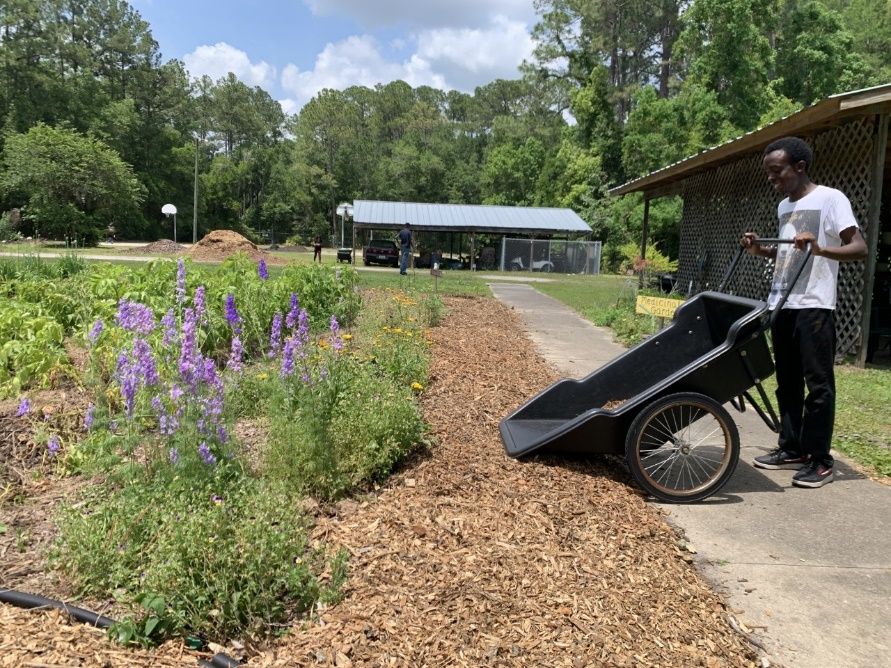
Credit: Jessica Williams, UF/IFAS
Safety Measures
Safety is always a priority when instructing a group through an activity of any sort. A variety of hazards can be present in a garden setting, so safety precautions need to be in place. These precautions need to be strictly enforced when working with individuals with special needs. One way to approach safety measures is to look at them through the Hierarchy of Controls, developed by the National Institute for Occupational Health and Safety (NIOSH) to make workplaces safer (https://www.cdc.gov/niosh/topics/hierarchy/default.html). Despite the potential for risks in the garden setting, most injuries are preventable with proper planning, which includes elimination of the risk, substitutions, administrative controls, and personal protective equipment. This section documents how these preventions can be implemented into a garden setting for participants with special needs.
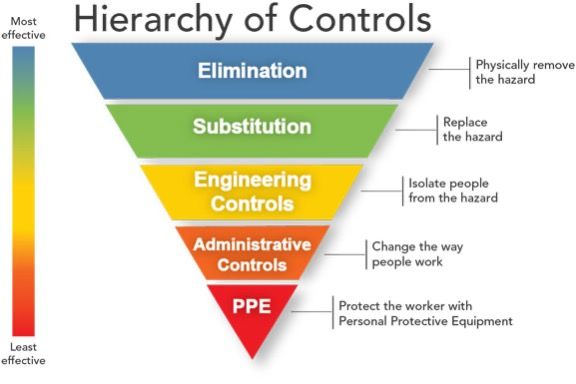
- Elimination: As shown in the diagram above of the Hierarchy of Controls, elimination is the most effective way to control the environment and ensure utmost safety. This is used in the garden through eliminating factors, such as tools or equipment being left out, path obstructions, and poor plant choices. Tools or equipment left out can be sharp or too large for certain participants and hazardous if picked up without supervision. Always putting away all tools and keeping equipment locked up prevents this from happening. On the note of putting everything away, it is important to ensure that there are no objects in the pathways that could be an obstruction to anyone in a wheelchair or walking through the paths.
- Substitution: Certain plants are toxic if ingested or have thorns/spikes that could be dangerous if handled incorrectly. It is best to eliminate this risk by only planting safe plants.
- Engineering controls: If there are plants already in the area that will be used for teaching, it is best to make sure they are in a clearly marked-off area to isolate them from people.
- Administrative controls can be used in the garden setting with participants with special needs. Administrative controls are rules that are put in place to change the way people work and to create a safer environment. An example of administrative control is providing visuals that would be helpful for people with a range of disabilities, such as informational signs or posters that include pictures as well as words and common symbols that signify what is and is not allowed. For example, if one of the activities involves harvesting, a step-by-step, how-to poster with pictures that demonstrate the process would be beneficial.
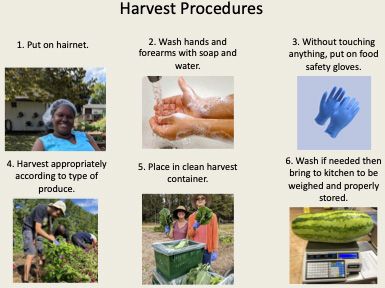
Credit: Jessica Williams, UF/IFAS
- Personal protective equipment (PPE) is used often in the garden setting. Many gardens grow plants that will be eaten; it is important to practice food safety measures that include PPE to make sure that the food harvested will be safe for consumption. Some ways to practice food safety are washing hands and wearing clean, food-safe latex gloves while harvesting, ensuring that participants are not touching their face or hair while harvesting, and storing the food that is harvested in a correct temperature environment. PPE also applies to gardens that do not grow plants for consumption. When working in any garden, which is usually outdoors, it is important to take precautions to protect participants from sun exposure or other environmental factors that may come up, such as red ant hills. Requiring participants to wear pants, closed-toe shoes, and hats; to bring a water bottle; and to wear sunscreen are some personal protective equipment recommendations.
In addition to the Hierarchy of Control methods, having a smaller instructor-to-student ratio will aid in making safety a priority. The recommended ratio will vary based on the activity, but having 5–6 participants per program leader/teacher is a very comfortable setting to work in. Smaller groups are beneficial because they allow the instructor to easily observe the participants and ensure that they are keeping out of areas that can be dangerous, using the tools correctly, and getting the attention and direction that is needed.
Educational Program Examples
When creating a program for participants with special needs in the garden, the first step should be to consider the audience and ask, “What do I want my participants to get out of this experience?” For example, the program could be to focus on obtaining a specific skill, such as growing herbs for an Extension program; learning a state educational standard, such as the five senses or implementing the scientific method for teachers; or simply conducting a fun, interactive activity. Deciding on the purpose will start the process of planning for the program based on strengths/abilities and goals of the participants. Once this has been established, it is time to gather supplies and plan accommodations, which are supports and strategies that need to be made in order for the program to be made accessible for every participant. The two programs provided as examples here—sensory gardens and plant trials—can be altered, based on the group of participants or size of the area being used for the program.
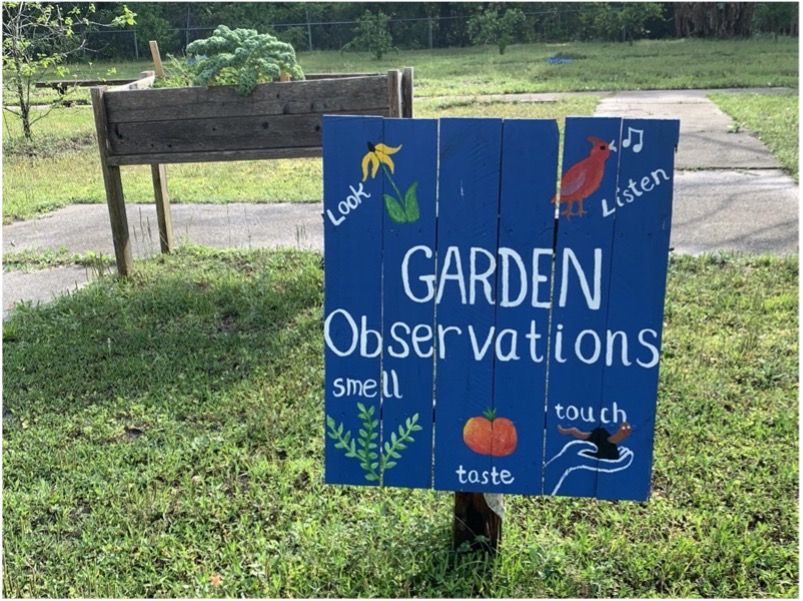
Credit: Jessica Williams, UF/IFAS
Sensory Gardens
Sensory gardens are used for instruction by teaching how we use our five senses with plants, like smelling different herbs or feeling different textures of plants. Sensory gardens can be used for instruction, socialization, and therapy (UF/IFAS Gardening Solutions, 2019). Socialization occurs during the teamwork that is necessary to build and maintain these gardens. Sensory gardens are oftentimes used in horticulture therapy as “the practice of engaging people in plant or gardening activities to improve their bodies, minds, and spirits” (Diehl, 2016). For more information on horticulture therapy, visit https://edis.ifas.ufl.edu/publication/EP145.
An Extension program, school garden, or home garden that demonstrates the processes of planting, maintaining, and harvesting plants in a sensory garden can be quite beneficial to participants with special needs. Suggested activities include the following:
- Allow participants to dig holes to plant seeds or transplants and discuss how the soil feels in their hands and why good soil is important for the plants.
- After planting, or for an already established sensory garden, have participants use watering cans to gently water the plants. Ask them to feel the water, if they are willing, and discuss how plants get thirsty and have needs just as we do.
- Next, especially when using herbs, have the participant rub the herb leaves and then smell the aroma. Provide questions such as, “What part of our body do we use to smell?” or “What does the smell of this herb remind you of? Pizza?” In addition to smelling the plant, feeling the different textures and asking them to describe if it feels soft or spiky is a great way to engage the participants.
- If there is an opportunity to taste the herbs or produce after harvesting and cleaning them, engage the participants with questions about whether they like or dislike the taste, if it was crunchy or soft, or if they had ever tried this before.
- Accommodations: If participants will be in wheelchairs, it is vital to have accessible garden beds or pots that can be reached from a seated position.
Plant Trials
Educational programs based on plant trials engage the participants in learning the scientific method, which is a process used in science starting with a question or problem, developing a hypothesis, testing the hypothesis through experimentation, and then analyzing the results, through a hands-on experience in the garden. This benefits the participants by teaching them a new skill and how those in the science profession use the scientific method, and it gives them the reward of growing their own food and reaping the harvest. An easy plant trial involves comparison of qualities of different varieties, like germination rate (how fast the seeds pop up after being planted) of a plant from the planting stage to harvest. Participants can also collect data on size of plants, weight of harvest, pest and disease damage, and the different tastes of produce. Through each of these processes, educators can discuss the scientific method and how scientists use this for their projects. For example, before planting, inquire what the students’ hypothesis is for which seed will germinate the quickest. Be sure to adapt language based on the vocabulary of the participants and define terms like “germination.”
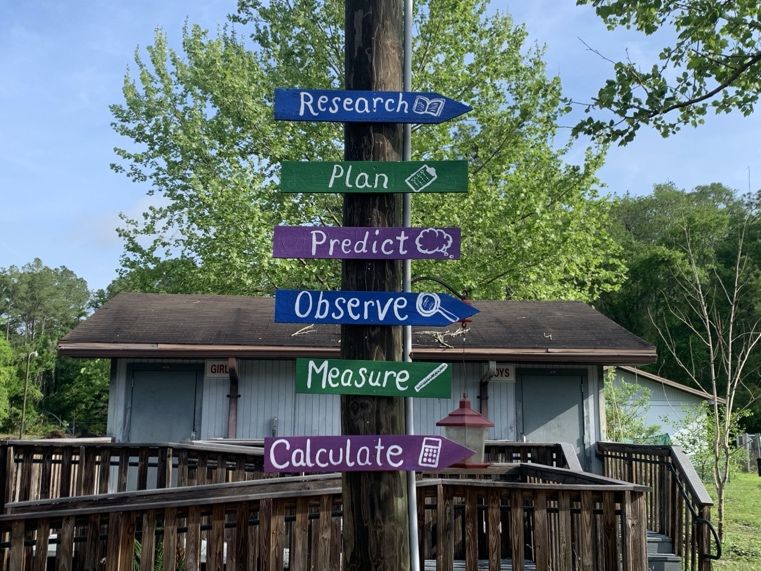
Credit: Jessica Williams, UF/IFAS
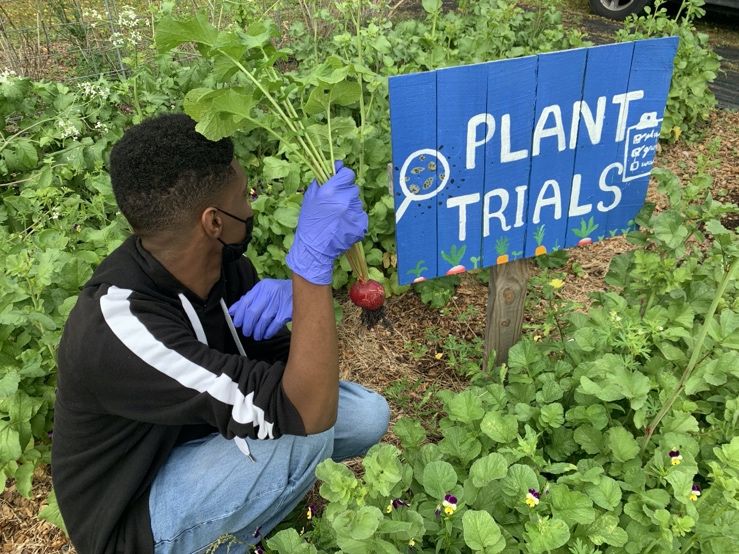
Credit: Jessica Williams, UF/IFAS
Summary
Working with people with special needs is highly rewarding for the individual leading the program and the participants. Extension agents, teachers, parents, or anyone instructing the activities need to be aware of the best practices to develop a successful program. Before planning and diving into the specifics of creating these programs, it is critical to understand both the needs and potential accommodations that exist, because programs may need to be altered to ensure that people with a range of abilities will be able to benefit from them. It is also important to be aware of how much gardening can benefit participants with special needs and plan the program based on different benefits, like sensory engagement, for example. When planning to build an area that will be used as a teaching garden, it is vital to focus on accessibility so that it can be enjoyed by all members of the community.
Here are some helpful links if you would like to learn more about working with the special needs population in a garden setting:
- Grow HUB (Growing Real Opportunities for Work): https://www.facebook.com/GROWHUBGNV/
- Growing Educational Training (GET) Campus’ Farm to School Work Hub: https://farm2schoolalachua.com/our-program/the-get-program/
References
Bravo, M. (2015). A guide for making community gardens accessible for all members. https://vcgn.org/vcgn2020/wp-content/uploads/2018/05/AccessibleCommunityGardensGuide-GrassrootsGardensofBuffalo.pdf
Centers for Disease Control and Prevention. (2020). Disability and health overview. https://www.cdc.gov/ncbddd/disabilityandhealth/disability.html
Diehl, E., and Brown, S. P. (2016). Horticultural therapy. EDIS, 2016(6). https://edis.ifas.ufl.edu/publication/EP145
Johnson, D. R. (2005). Key provisions on transition: A comparison of IDEA 1997 and IDEA 2004. Career Development for Exceptional Individuals, 28(1), 60–63.
Kids Gardening. (2020). Garden how-to: Create an accessible garden for those with physical limitations—Kids gardening. https://kidsgardening.org/garden-how-to-create-an-accessible-garden
Sze, S. (2009). Learning style and the special needs child. Journal of Instructional Psychology, 36(4), 360–363.
UF/IFAS Gardening Solutions. (2013). Accessible gardens. https://gardeningsolutions.ifas.ufl.edu/design/types-of-gardens/accessible-gardens/
UF/IFAS Gardening Solutions. (2019). Sensory Gardens. https://gardeningsolutions.ifas.ufl.edu/design/types-of-gardens/sensory-gardens/
University of Minnesota. (2021). What are intellectual and developmental disabilities? https://ici.umn.edu/welcome/definition
Wills, K. (2012). Gardening with special needs: The benefits of horticultural therapy. https://www.canr.msu.edu/news/gardening_with_special_needs_the_benefits_of_horticultural_therapy
World Health Organization. (2001). International classification of functioning, disability and health (ICF). Geneva.